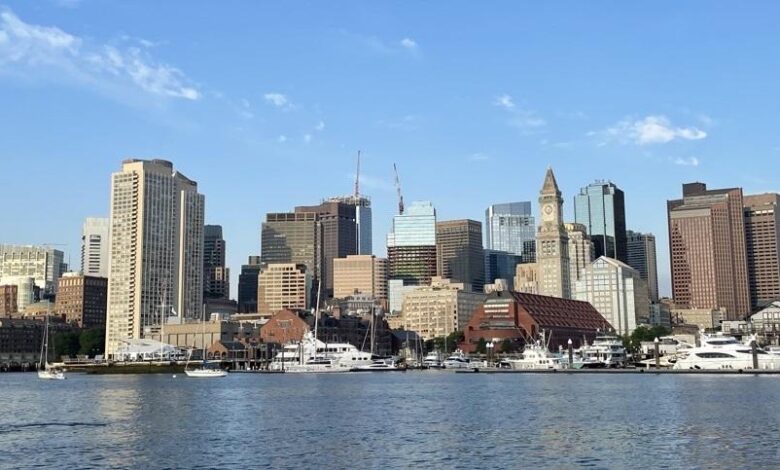
Climate change is significantly impacting Boston’s waterfront in several ways. One of the most prominent effects of climate change on Boston’s waterfront is sea level rise. Over the past century, sea levels in Boston have risen by around 11 inches. This rise increases the frequency and severity of coastal flooding during storms and high tides, leading to erosion and damage to infrastructure.
Sea level rise is a significant consequence of climate change, driven primarily by two factors: thermal expansion of seawater as it warms and the melting of ice sheets and glaciers. Sea levels have risen globally by about 8-9 inches (20-23 cm) since 1880, and the rate of rise has accelerated in recent decades. This trend is expected to continue and possibly accelerate further depending on future greenhouse gas emissions.
Sea level rise is not uniform across the globe. Local factors such as land subsidence, ocean currents, and gravitational effects can cause variations in sea level rise from region to region. Coastal areas are particularly vulnerable to sea level rise. Higher sea levels increase the risk of coastal flooding, erosion, and saltwater intrusion into freshwater sources.
Warmer temperatures due to climate change lead to increased evaporation rates, which can result in more intense and frequent precipitation events. This means that when it does rain, it often pours, leading to higher volumes of water that can overwhelm drainage systems and cause flooding. Urban areas are particularly vulnerable to flooding due to increased impervious surfaces (like roads and buildings) that reduce natural drainage and increase runoff. Aging infrastructure in many cities also contributes to drainage problems during heavy rainfall events.
Climate change can affect river flooding patterns by altering precipitation patterns and increasing the likelihood of extreme weather events. This can lead to more frequent and severe riverine flooding, impacting communities along riverbanks. Intense precipitation events can trigger flash floods in urban and rural areas, causing rapid inundation and posing significant risks to lives and property. Increased flooding can disrupt communities, causing property damage, displacement of residents, disruption of businesses and services, and loss of infrastructure.
Vulnerable populations, including low-income communities and those without adequate flood protection, are often disproportionately affected. To address increased flooding, communities are implementing various adaptation strategies. These include improving stormwater management, enhancing flood defenses (such as levees and floodwalls), restoring natural floodplain functions, and incorporating climate resilience into urban planning and infrastructure design. Effective adaptation strategies and global efforts to mitigate climate change are crucial to reduce the risks and impacts associated with increased flooding.
Climate change is linked to the increased intensity of storms, including hurricanes and nor’easters. These storms can cause significant damage to Boston’s waterfront infrastructure, including buildings, roads, and utilities. Storm intensity refers to the strength or power of a storm, typically measured by various meteorological parameters such as wind speed, central pressure (for cyclones), and sometimes by the amount of precipitation or the extent of damage caused. We are seeing more intense storms that bring stronger winds and heavier precipitation”- said one Boston Climate Action Network.
The extent of damage caused by a storm can also be used as an indicator of its intensity. This includes damage to buildings, infrastructure, and the environment. Modern meteorology uses advanced satellite and radar technology to monitor storms in real-time, providing detailed information on their structure, intensity, and potential impact. To mitigate the impacts of storm intensity on Boston’s waterfront, urban planners and engineers may implement various strategies such as ensuring that new construction and renovations adhere to stringent building codes that account for potential storm impacts.
Rising global temperatures contribute to warmer ocean waters, which can impact marine life and ecosystems along the Boston waterfront. This can affect fisheries, habitats, and biodiversity. Warmer temperatures, driven by climate change, have a range of effects on Boston and its surrounding areas. As global temperatures rise, Boston experiences more frequent and intense heat waves. Heat waves can pose significant health risks, especially for vulnerable populations such as the elderly and those with pre-existing health conditions.
Heat-related illnesses like heat stroke and dehydration become more common during prolonged periods of hot weather. Urban areas like Boston tend to be warmer than surrounding rural areas due to the urban heat island effect. This phenomenon is exacerbated by factors such as the concentration of buildings and infrastructure, reduced green spaces, and increased energy use. The urban heat island effect can further elevate temperatures in the city, especially during heat waves.
Warmer temperatures increase the demand for cooling systems such as air conditioning in buildings and homes. This leads to higher energy consumption during hot weather, putting stress on the electrical grid and potentially increasing costs for consumers. Increased energy demand also contributes to greenhouse gas emissions, further exacerbating climate change. Warmer temperatures affect local ecosystems and biodiversity. They can alter the distribution and behavior of plant and animal species, including those in Boston’s parks and green spaces.
For example, changes in temperature can impact flowering and migration patterns, disrupt food webs, and affect species interactions. While not directly related to warmer air temperatures, the overall warming of the climate contributes to melting ice caps and glaciers, leading to sea level rise. Understanding the impacts of warmer temperatures on Boston is crucial for developing effective climate adaptation and mitigation strategies that can enhance resilience, protect public health, and preserve the city’s natural and built environment in the face of ongoing climate change. Many of Boston’s critical infrastructure systems, such as transportation networks and utilities, are located near the waterfront and are vulnerable to climate change impacts.
To address these challenges, Boston has been implementing various adaptation measures. These include building seawalls and berms to protect against flooding, redesigning waterfront areas to be more resilient, and updating building codes to account for higher sea levels. “We must adapt to these changes by investing in resilient infrastructure and sustainable development.” according to Boston Harbor Now. Boston has been actively implementing various adaptation efforts to address the challenges posed by climate change and enhance the city’s resilience.
Launched in 2016, Climate Ready Boston is the city’s ongoing initiative to prepare for the impacts of climate change, particularly sea level rise and extreme weather events. It involves extensive research, analysis, and community engagement to develop actionable strategies for adapting infrastructure, buildings, and neighborhoods. This initiative focuses on protecting Boston’s waterfront from rising sea levels and storm surges.
Boston is actively implementing adaptation strategies such as seawalls, green infrastructure, and updated building codes to protect the waterfront and enhance resilience against climate change impacts. Boston promotes the use of green infrastructure to manage stormwater, reduce urban heat island effects, and enhance biodiversity. Green infrastructure features include rain gardens, permeable pavement, green roofs, and urban parks designed to absorb rainwater and reduce runoff.
Boston has updated building codes and standards to ensure that new construction and renovations consider climate resilience. This includes requirements for flood-resistant building designs, elevated structures in flood-prone areas, and energy-efficient building practices to reduce carbon emissions. The city is improving transportation infrastructure resilience to withstand extreme weather events and sea level rise. This includes upgrading drainage systems, elevating vulnerable roadways, enhancing public transit resilience, and promoting alternative transportation modes to reduce carbon emissions.
Boston engages residents, businesses, and community organizations in climate adaptation efforts through workshops, outreach programs, and educational campaigns. Community involvement is crucial for fostering resilience and ensuring that adaptation strategies meet local needs and priorities. Collaboration with regional, national, and international partners strengthens Boston’s adaptation efforts. Partnerships involve sharing knowledge, resources, and best practices to develop innovative solutions for climate resilience.
Boston integrates considerations of health and social equity into its adaptation strategies. This includes addressing heat-related health risks, ensuring access to cooling centers during heat waves, and enhancing social services to support vulnerable populations affected by climate impacts. These adaptation efforts reflect Boston’s commitment to proactively addressing climate change impacts and building a more resilient and sustainable city. Continued investment in adaptation measures, coupled with ongoing monitoring and evaluation, will be essential for safeguarding Boston’s infrastructure, economy, and quality of life in a changing climate.
Overall, climate change is posing significant challenges to Boston’s waterfront, requiring ongoing adaptation and mitigation efforts to protect the city and its residents from future impacts.



